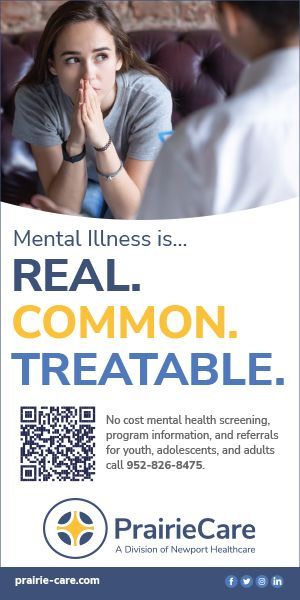orkplace injuries, and their resulting economic impact, make up a much larger issue than most people are aware of. According to the National Safety Council, in 2021 the financial impact was $167 billion and 70 million injuries occurred at work. Several distinct elements must be considered when measuring this impact, including initial cost of treating the injury, lost workplace productivity, potential ongoing state and federal health care and unemployment benefits and emotional/behavioral health concerns.
cover story one
The Minnesota RETAIN Study
Chiropractic care in return to work issues
By Deb Zurcher, LAc, DC
To address these issues the U.S. Department of Labor and the Social Security Administration have undertaken a research project, called Retaining Employment and Talent after Injury/Illness Network (RETAIN). This study focuses on getting workers back to work. Minnesota was one of five states selected to participate in the trial project, and the Minnesota Department of Employment and Economic Development was awarded $19,518,509, which was provided incrementally and 100% of which is from U.S. federal funds.
Goals
The Minnesota RETAIN program’s primary goal is to provide early intervention strategies for workers to stay at work or return to work as soon as medically possible after an injury or illness, occurring on or off the job, that impacts their employment. Minnesota RETAIN is different from many other stay-at-work/return-to-work programs because the enrollees are assigned a return-to-work (RTW) case manager, who becomes an integrated member of the enrollee’s medical team.
A person’s job is a social determinant of health.
Minnesota RETAIN also assists workers that cannot be accommodated in their regular jobs. They may have the option of working with a career navigator who might be able to create an individualized employment plan for the worker.
The study will evaluate the benefits of early interventions to help Minnesota workers stay at work or return to work as quickly as possible. A person’s job is a social determinant of health and part of what makes up the basics of health and prosperity. Without a job, having excessive time off work can lead to a “new normal.” This can lead to deconditioning; withdrawal from colleagues, friends, and family; depression, anxiety, financial insecurity, losing the feeling of self-worth and hope for the future; and even to mortality. This withdrawal can occur in as short as a few months. Data show that if someone is out of work more than three months, only 50% return to work, and if that time is over 12 months, only 5% return to work. This results in escalating costs to the worker, the employers and the state of Minnesota.
How it Works
During the phase I of the demonstration project, the Minnesota RETAIN program successfully developed protocols, processes, and collaboration among various state agencies, workforce development organizations and others. It served 150 ill and or injured workers. Phase II expanded the program to include 3,200 participants across Minnesota and is designed to validate and bring to scale evidence-based strategies aimed to increase employment retention and to reduce long-term work disability. Primary goals of phase II include statewide expansion and support to ill and or injured workers especially underserved populations. Workers must have the right to work in the U.S. to receive RETAIN services. These services may be provided to individuals who are unemployed or do not have existing workers’ compensation litigation. Qualifying conditions can include chronic illness, behavioral health (including substance-use disorders), musculoskeletal issues and more. The largest category of injury comes from musculoskeletal injuries, which is why Fulcrum Health joined Minnesota RETAIN as part of the phase II expansion.
The study required recruitment of both patients and providers. The goal is to enroll 3,200 patients by May 2024, and when this article first appeared 2,400 were already enrolled and 90% of all Minnesota counties had some level of participation.
Once enrolled, half the patients receive the services of an RTW case manager to serve as a liaison between the worker, the health care provider, the employer and other stakeholders to help the patient access services needed to return to work. Any Minnesotan is eligible to participate if they are at least 18, meet the following requirements, and are not in any ineligible groups. They must live and work in Minnesota, have worked at least one day in the past six months, and have a personal or work-related injury, illness, or surgery that will impact their ability to work. Patients may self enroll on the Minnesota RETAIN web site or be referred by any provider. Once accepted, patients are randomized to the intervention group where they receive services to support or sustain their employment, retain job skills, and help ease the transition back to work. Participants in the control group are accepted into the study but not assigned a case manager. The control group participants continue with their treatment and return to work if possible in their own time. The study will review the effectiveness of having a case manager.
A wide range of providers may participate. Referring providers, however, must complete a 45-minute CME training course on preventing needless work disability. This course emphasizes the need for managing the time away from work in a positive and productive manner. Providers must be the ones to help the patients’ health issues and give them activities to support their recovery. Having a broad range of participating providers registered within the Minnesota RETAIN network to help the patient is a much-needed asset for busy caregiver schedules, and it also provides the best resources to patients.
The Role of Chiropractic Care
Fulcrum Health Inc. is a nonprofit physical medicine benefit-management organization with a mission to improve the quality of life for individuals and communities by delivering high-value physical medicine networks to health plans and employer groups. We represent a standard of excellence among chiropractors and are focused on first-line, non-pharmacological, physical medicine. We are excited to be involved with this statewide research study. Fulcrum’s participation allows access to more than 2,400 chiropractors in its ChiroCare network to refer patients to the Minnesota RETAIN study. Once accepted, those patients who are randomized to the intervention group receive services to support or sustain their employment, retain job skills and help ease the transition back to work.
If someone is out of work more than three months, only 50% return to work.
Chiropractic care provides early intervention and is a non-pharma, best practice, first-line approach to back and joint injuries. The care includes at home instructions ensuring the patient is making the correct movements and exercises. It also provides instructions on how to avoid further injury. The treatment plan starts by leading and supporting patients in owning their recovery and self-management. This is effective in providing back pain and musculoskeletal (MSK) care and supporting the quick return to work post injury, as can be seen in the following condensed case studies.
Sally had been working at the same desk job for 20 years. She had some arm and wrist pain but was trying to make the best of it. The final straw was dropping the Thanksgiving turkey on the floor; subsequently she went on leave from work due to the pain. After a thorough history and exam her chiropractor diagnosed carpal tunnel syndrome. She was prescribed a treatment plan that included specific adjustments to her neck, elbow and wrist. The plan also included manual work, stretches that included her forearms, strengthening exercises for her back and neck, and recommendations for lifestyle changes. An ergonomic assessment at work provided accommodations that could help her return to her job. She continued to see the chiropractor for another two weeks and then was released from care. She now has the needed tools to be productive at work without pain and discomfort.
Bruce injured his back lifting a wheelbarrow full of dirt. He had heard a pop and went down, barely able to move. Working was out of the question, and he was removed from his work schedule. After a chiropractic exam, a sprain/strain and segmental dysfunction were diagnosed. X-rays revealed an indication of past trauma to the area. After treatment started, which included daily adjustments, physiotherapy and computerized traction to his low back, improvements came within a few days. Kinesio tape was used to support the muscles of the low back and help reduce inflammation. An anti-inflammatory diet was also recommended, as were walking and lots of water. He was able to return to work in a week, with restrictions and accommodations. In two weeks, he was back at work full time, though still with some restrictions. After three weeks he was back full time. He was still working with his chiropractor, who progressed him to home exercises and a less aggressive treatment schedule. After four weeks, he was feeling better than he had before he hurt himself. He was released from care.
Sometime in our life 80% of us will have an MSK disorder. As many as 30% of those occasions may lead to time off work or working with restrictions. Quick access to care from a chiropractor, along with the support of a Minnesota RETAIN RTW case manager, provides a winning team, not only for the patient, but also for the state of Minnesota.
As a chiropractor for more than 25 years, I almost take for granted the need to stay at work. Chiropractors work with the human body to reduce and remove pain, allowing our patients to remain at work or get back to work very quickly. I have seen how important easy access and effective care are to reduce patient fear about pain and to begin steps to improve their ability to perform activities of daily living. For example, I had a 44-year-old patient who was injured and could barely move, much less work. He had been to the emergency room but did not want prescription medication. He was genuinely concerned about getting back to work to support his family and knew his injuries would take time. As his pain reduced, he was able to begin strengthening the weakened muscles. The satisfaction of seeing those positive changes and hearing the wins of patients as they progressed after an injury makes every day as a chiropractor very rewarding.
When Fulcrum learned of this statewide federally funded study it made sense to reach out and participate. Subsequently we were invited to be sub-recipients and first approached our Centers of Excellence providers to become referring providers. Participation has produced outstanding results. “I am thankful to have Minnesota RETAIN as a resource for my patients. One of the patients I referred was connected with some really amazing resources,” states Dr. Hans Thurmer, with Arrow Health Chiropractic + Rehab. Dr. Thurmer found that Minnesota RETAIN has been excellent in its communication and supported the patient in every step. The support of a chiropractor or health care provider is an important contribution to the success of this free and innovative study.
Next Steps
If you are a health care provider interested in referring out-of-work or restricted work patients to this important study, please contact Minnesota RETAIN to find out more about how to get involved. As a chiropractor or health care provider, by direct contact encouraged to enroll interested patients by calling Minnesota RETAIN or directly through the website www.mnretain.com.
Many organizations are already participating, including the Minnesota Department of Employment and Economic Development, the Minnesota Department of Health, the Minnesota Department of Labor and Industry, the Governor’s Development Board, Workforce Development Inc. and others. Fulcrum Health is proud to support ChiroCare chiropractors with their participation in being referring doctors for the Minnesota RETAIN study and keeping Minnesota working.
Deb Zurcher, LAC,
is the assistant chief clinical officer at Fulcrum Health Inc. Serving 3.2 million members in the Midwest, Fulcrum Health is NCQA accredited and for over 40 years has delivered quality care through its credentialed chiropractic providers. For more information, visit fulcrumhealthinc.org.
MORE STORIES IN THIS ISSUE
cover story one
The Minnesota RETAIN Study: Chiropractic care in return to work issues
By Deb Zurcher, LAc, DC
cover story two
Safeguarding Men’s Health: The role of sperm counts






















